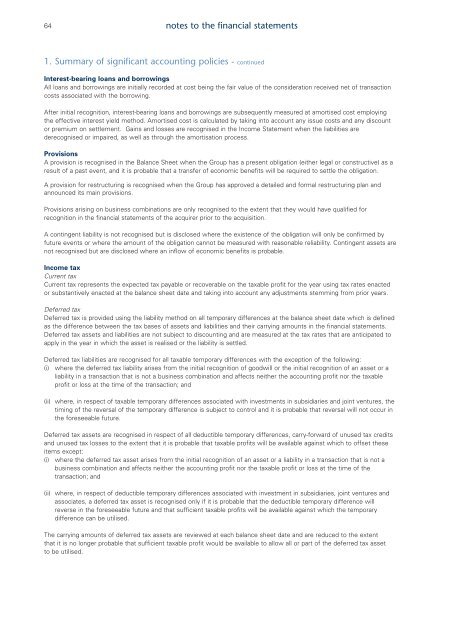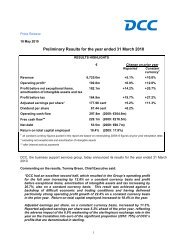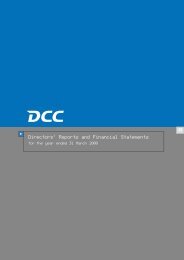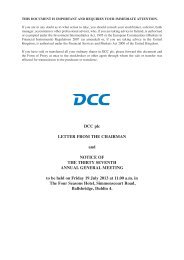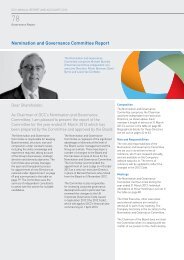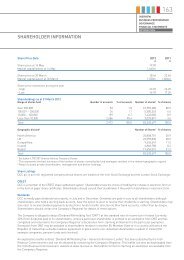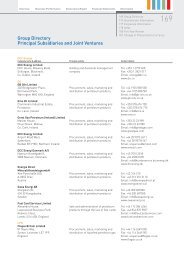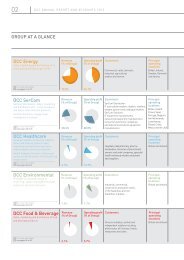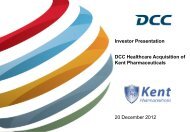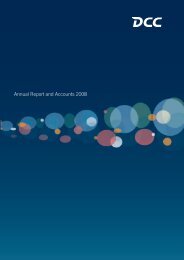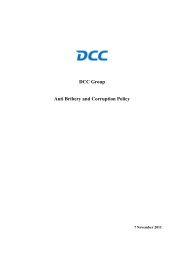Annual Report and Accounts 2006 - DCC plc
Annual Report and Accounts 2006 - DCC plc
Annual Report and Accounts 2006 - DCC plc
Create successful ePaper yourself
Turn your PDF publications into a flip-book with our unique Google optimized e-Paper software.
64notes to the financial statements1. Summary of significant accounting policies - continuedInterest-bearing loans <strong>and</strong> borrowingsAll loans <strong>and</strong> borrowings are initially recorded at cost being the fair value of the consideration received net of transactioncosts associated with the borrowing.After initial recognition, interest-bearing loans <strong>and</strong> borrowings are subsequently measured at amortised cost employingthe effective interest yield method. Amortised cost is calculated by taking into account any issue costs <strong>and</strong> any discountor premium on settlement. Gains <strong>and</strong> losses are recognised in the Income Statement when the liabilities arederecognised or impaired, as well as through the amortisation process.ProvisionsA provision is recognised in the Balance Sheet when the Group has a present obligation (either legal or constructive) as aresult of a past event, <strong>and</strong> it is probable that a transfer of economic benefits will be required to settle the obligation.A provision for restructuring is recognised when the Group has approved a detailed <strong>and</strong> formal restructuring plan <strong>and</strong>announced its main provisions.Provisions arising on business combinations are only recognised to the extent that they would have qualified forrecognition in the financial statements of the acquirer prior to the acquisition.A contingent liability is not recognised but is disclosed where the existence of the obligation will only be confirmed byfuture events or where the amount of the obligation cannot be measured with reasonable reliability. Contingent assets arenot recognised but are disclosed where an inflow of economic benefits is probable.Income taxCurrent taxCurrent tax represents the expected tax payable or recoverable on the taxable profit for the year using tax rates enactedor substantively enacted at the balance sheet date <strong>and</strong> taking into account any adjustments stemming from prior years.Deferred taxDeferred tax is provided using the liability method on all temporary differences at the balance sheet date which is definedas the difference between the tax bases of assets <strong>and</strong> liabilities <strong>and</strong> their carrying amounts in the financial statements.Deferred tax assets <strong>and</strong> liabilities are not subject to discounting <strong>and</strong> are measured at the tax rates that are anticipated toapply in the year in which the asset is realised or the liability is settled.Deferred tax liabilities are recognised for all taxable temporary differences with the exception of the following:(i) where the deferred tax liability arises from the initial recognition of goodwill or the initial recognition of an asset or aliability in a transaction that is not a business combination <strong>and</strong> affects neither the accounting profit nor the taxableprofit or loss at the time of the transaction; <strong>and</strong>(ii) where, in respect of taxable temporary differences associated with investments in subsidiaries <strong>and</strong> joint ventures, thetiming of the reversal of the temporary difference is subject to control <strong>and</strong> it is probable that reversal will not occur inthe foreseeable future.Deferred tax assets are recognised in respect of all deductible temporary differences, carry-forward of unused tax credits<strong>and</strong> unused tax losses to the extent that it is probable that taxable profits will be available against which to offset theseitems except:(i) where the deferred tax asset arises from the initial recognition of an asset or a liability in a transaction that is not abusiness combination <strong>and</strong> affects neither the accounting profit nor the taxable profit or loss at the time of thetransaction; <strong>and</strong>(ii) where, in respect of deductible temporary differences associated with investment in subsidiaries, joint ventures <strong>and</strong>associates, a deferred tax asset is recognised only if it is probable that the deductible temporary difference willreverse in the foreseeable future <strong>and</strong> that sufficient taxable profits will be available against which the temporarydifference can be utilised.The carrying amounts of deferred tax assets are reviewed at each balance sheet date <strong>and</strong> are reduced to the extentthat it is no longer probable that sufficient taxable profit would be available to allow all or part of the deferred tax assetto be utilised.


